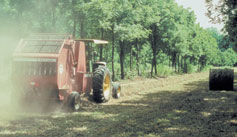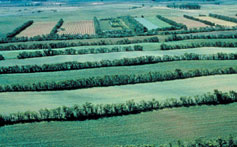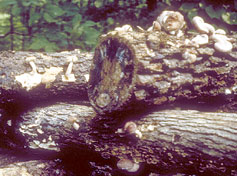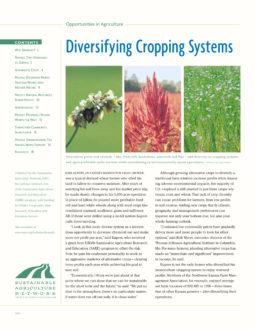
Agroforestry integrates trees and shrubs with crop or livestock operations to create more diverse farms, ranches and communities. Research and field demonstrations of a wide range of practices from around the country prove that trees and shrubs provide numerous economic and environmental benefits.
Those benefits have not been lost on farmers and ranchers, who are employing agroforestry strategies in increasing numbers, said Greg Ruark, director of USDA’s National Agroforestry Center (NAC) in Lincoln, Neb.
“Small producers can readily integrate many agroforestry practices into their existing operations and realize an economic benefit, both in terms of added income and reduced operating costs,” he said.
Alley Cropping
Planting trees and row crops side by side in strips, or alleys, offers great profit potential. By growing cash crops simultaneously with a long-term tree crop, farmers can earn annual income while the trees mature. Hardwoods like walnut, oak, ash and pecan produce high-value logs for lumber or veneer.
While configuration can vary greatly, trees usually are planted in single rows, widely spaced. The spaces allow room for the annual crops as well as easy access for farm machinery. You can grow hay, wheat, soybeans and corn, as well as many vegetables and such specialty crops as St. John’s Wort, a popular medicinal herb. Consider planting a ground cover, such as a grass-legume mix, under the tree rows in a strip extending to the width of the tree crowns.
When the trees are small, the annual row crops occupy most of the field and provide virtually all ofthe income. Most nut crops begin to generate income within five to 10 years. As the trees grow larger and the level of shade increases, some producers plant specialty crops that require partial shade, like ginseng or goldenrod, for an added return.
Alley-cropping systems that match the light, water and nutrient requirements of both the tree and the agricultural crops lower economic risks by diversifying farm income while providing erosion control, wildlife habitat and a diversity of niches for beneficial insects.
Windbreaks

The use of tree strips to control wind erosion has been promoted in the United States since the “dust-bowl” era of the 1930s. Many of the early windbreaks have since been cut down or have lost their effectiveness due to age.
Research has shown, however, that windbreaks provide agricultural benefits that go beyond erosion control. On a per-field basis, crop yield is almost always greater because windbreaks reduce crop transpiration and field evaporation losses.
Livestock operators can use windbreaks to provide shelter for animals. Thanks to several rows of windbreaks, a North Dakota producer maintained all of his cows during a late-winter blizzard that caused other ranchers to lose 40 to 60 percent of their herds.
Tree strips that also include grasses and legumes provide habitat for wildlife, beneficial insects and pollinating bees. Windbreaks can even help communities with harsh winters better handle the dangerous impact of winter storms and significantly reduce home heating costs.
Producers in Washington’s Columbia Basin planted windbreaks to protect more than 35,000 acres of fruit orchards from wind damage, according to the NAC. One row of poplar trees planted seven to 10 feet apart provides about 600 feet of protection. Delicate apple trees benefit when fruit- and limb-damaging winds are reduced in orchards.
Silvopasture
Many pastures include an occasional tree that either grew inadvertently or is a remnant from earlier land management activity. What sets silvopasture apart is the purposeful integration of trees and pasture to gain optimum economic return. A variety of tree arrangements can create effective silvopasture systems, with animal stocking density dependent on soils, climate, and the selected tree and pasture plant species.
Recent research demonstrates that many forage grasses grow as well or better under up to 50 percent shade as they do in an open pasture. Silvopasture systems use the same acre of land for livestock grazing and growth of high-value timber. Livestock – from cattle to hogs – benefit from the shade and shelter trees provide.
Forest Farming

Cultivating high-value specialty crops under a forest canopy that has been modified to provide the appropriate amount of light and micro-climatic conditions can bring very good returns. Called forest farming, this practice maintains the forest’s ability to stabilize soil, provide wildlife habitat, and cycle water and nutrients while modifying the forest understory. Growers adjust the amount of light allocated to the understory by thinning, pruning or adding trees. Consider growing ginseng, shiitake mushrooms and decorative ferns for medicinal, culinary or ornamental uses in a number of markets, including directly to consumers.
Field Borders
Field and roadside borders are an often-overlooked area to add plant diversity from mixed stands of native perennial plants. They provide habitat for beneficial insects and birds that prey on insect pests. The borders also help prevent wind and water erosion and help stop snowdrift. Perennial borders do not require mowing and – once established – easily outcompete annual weeds. Native perennials also add to the appearance of the landscape. Local NRCS offices can recommend an appropriate mix of plants for your area as well as establishment methods.
